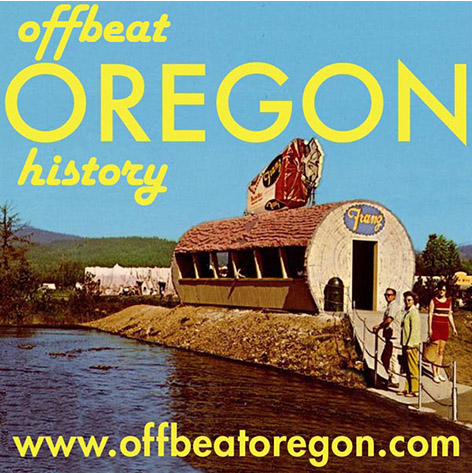
Looking for more?
On our Sortable Master Directory you can search by keywords, locations, or historical timeframes. Hover your mouse over the headlines to read the first few paragraphs (or a summary of the story) in a pop-up box.
... or ...
SCIO, OCHOCO N.F., PETERS CREEK SINK:
If only these bones could talk ...
Audio version: Download MP3 or use controls below:
|

The Odd Fellow's bones In August of 2010, a 16-year-old girl named Jenny Minten was helping clean out a closet at the International Order of Odd Fellows hall in Scio, when she made a startling and creepy discovery. It was a small black casket full of human bones. The bones turned out to be part of the ceremonial accoutrements of the Scio Odd Fellows. This particular chapter was chartered in 1856, and the induction rituals for the Odd Fellows include a memento mori — usually in the form of a skeleton. Today, active Odd Fellows chapters don’t typically use real skeletons for this, but at one time they did. This particular skeleton was bought out of a catalog — an Odd Fellows “regalia and paraphernalia” catalog — sometime in the late 1800s, according to the recollections of Scio Odd Fellows and Rebekahs members. The cranium of the skeleton's skull had been neatly sawn in half, suggesting that the skeleton was a “retired” medical-school subject. This raises a number of fascinating questions. In the late 1800s, most people weren’t open to the idea of donating their bodies to science, and it was quite difficult for medical schools to slake their thirst for fresh cadavers to dissect. So an entire underground industry developed on the East Coast — an industry devoted to stealing corpses and selling them to medical schools. Body snatchers, or “resurrectionists” as they called themselves, would prowl graveyards looking for fresh diggings, and bribe undertakers to slip them corpses. They’d even go into poorhouses and impersonate relatives so they could claim bodies. (In Britain, some body snatchers actually started murdering people so their bodies could be sold. In the U.S., so far as is known, nobody ever went quite that far. But Portland had a sort of celebrity-body-snatching incident involving city father William Ladd, which is covered in another Offbeat Oregon article, which you'll find here.) All of which is to say that it is somewhat unlikely the man whose bones the Odd Fellows bought had any idea that this would be his fate. The bones were donated to the Oregon State University anthropology department, where they were cleaned and analyzed and served as the subject of OSU student Dawn Marie Alapisco’s Honors College thesis. Alapisco reports the bones belonged to a powerful, strong man, nearly six feet tall and ripped; the skeleton had developed in a way that telegraphed “muscular hypertrophy.” His neck, back and knees were worn and bent in ways that suggested he’d carried many heavy loads. And he’d died of tuberculosis, which had eaten into his bones; by the time he died, his right arm would have been useless. He was 45 to 55 years old. He died sometime between 1860 and 1890, but probably closer to 1890, since that’s when his bones were sold. That means he would have been at or near fighting age during the American Civil War. Did he fight in it? What did he do for a living, this job that made his muscles so big and wore him out so soon? Could he have been a deepwater sailor? His skull bears an odd resemblance to Popeye the Sailor Man. Or was he perhaps a “misery whip”-era logger, or longshoreman, or something else? Did he have a family, maybe a son or daughter to bury him and cry and put flowers by his tombstone, never dreaming that someone had slipped by one night and stolen his corpse out of the ground? Or was he one of those unclaimed dead in the poorhouse, left destitute after a life of working too hard for not enough, with no family, dying painfully of consumption, alone? Just one thing is sure: We’ll never know.
|
©2008-2023 by Finn J.D. John. Copyright assertion does not apply to assets that are in the public domain or are used by permission.






